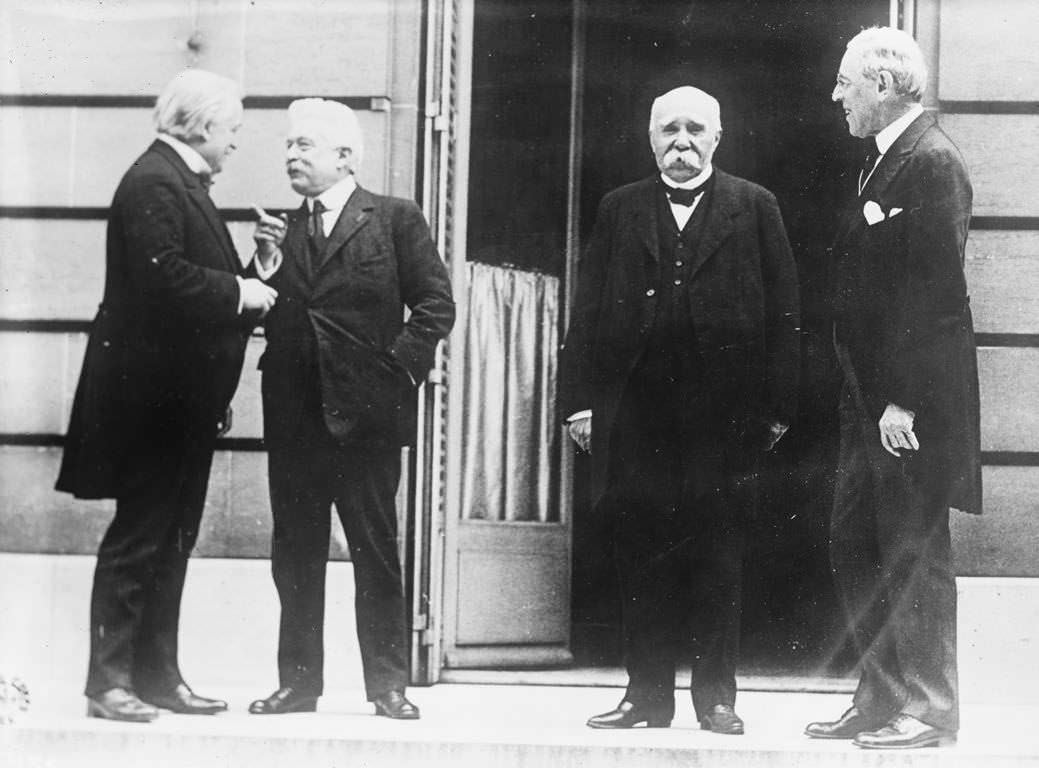All was quiet on the Western Front at 11:00 a.m. on November 11, 1918.

The German Empire’s Kaiser Wilhelm II had fled to the Netherlands, and a new German Republic was established. The Great War earned its name—more than 8.5 million soldiers died. Its battlefields littered Europe, Africa, and the Middle East. Troops from many of Europe’s countries and also including Africa, China, Japan, New Zealand, Australia, Canada, India, and the United States had engaged in battle.
By the end of the war, the empires that had seemed so indestructible just a few years before had either collapsed during the war or crumbled after it was over. The regimes included the Hapsburgs in Austria–Hungary, the Romanovs in Russia, the Turks in the Ottoman Empire, and the Hohenzollerns in Germany. Britain, while still an empire, was left in a weakened state. Some of its former dominions signed peace treaties as the independent countries of Canada, Australia, New Zealand, and South Africa.
NEGOTIATING PEACE
The war’s end brought the daunting task to negotiate peace on a scale never before seen. Officials convened in France in January 1919 for the Paris Peace Conference. The top three diplomats to participate were French prime minister Georges Clemenceau, British prime minister David Lloyd George, and U.S. president Woodrow Wilson. They dominated the conference. Although the United States had been involved in the war for only 19 months, European powers needed its money and supplies.
هذه القصة مأخوذة من طبعة May/June 2017 من Cobblestone American History Magazine for Kids.
ابدأ النسخة التجريبية المجانية من Magzter GOLD لمدة 7 أيام للوصول إلى آلاف القصص المتميزة المنسقة وأكثر من 9,000 مجلة وصحيفة.
بالفعل مشترك ? تسجيل الدخول
هذه القصة مأخوذة من طبعة May/June 2017 من Cobblestone American History Magazine for Kids.
ابدأ النسخة التجريبية المجانية من Magzter GOLD لمدة 7 أيام للوصول إلى آلاف القصص المتميزة المنسقة وأكثر من 9,000 مجلة وصحيفة.
بالفعل مشترك? تسجيل الدخول

Eye in the Sky
An interview with Joe Piotrowski

Airborne Animals
Humans have taken to the skies in balloons, gliders, and airplanes-but we're not alone among the clouds. Animals of all sorts have evolved to harness wind power.

TAKING OFF
The Wright brothers expected airplanes to “take off,” but even they might be amazed at the way the airline industry has become big business. In the past, it was expensive to send something by plane.

GROWTH OF AN INDUSTRY
After their historic flight at Kitty Hawk in 1903, Wilbur and Orville Wright returned to Dayton, Ohio. They spent the next few years making adjustments and building additional versions of their powered aircraft in their bicycle shop.

WHY KITTY HAWK?
The Wright brothers searched carefully for the best place to test their gliders and flying machines. Their main concern was for good, steady winds. But they also hoped to find a remote location to allow them to perform tests away from the public eye.

Two Brothers From Ohio
Most people do not realize that the Wright brothers—Wilbur, born in 1867, and Orville, born in 1871—performed various scientific experiments before inventing their aircraft. For as long as anyone in their hometown of Dayton, Ohio, could remember, the Wright boys had worked on mechanical projects.

A Helping Hand
May 6, 1896. A group of people who had gathered beside the Potomac River, just south of the U.S. capital, grew quiet. Then, it erupted in cheers as a small, unmanned aircraft took to the skies and flew for more than half a mile. The flight came seven years before the Wright brothers’ first manned, powered flight. The inventor of the aircraft was Dr. Samuel Pierpont Langley.

THE IDEA MEN
People dreamed of flying thousands of years before the Wright brothers found success near Kitty Hawk, North Carolina. These dreamers, such as Leonardo da Vinci, studied birds flying and imagined how humans might do the same—if only they had wings. Other men developed a more hands-on approach to the topic. Early inventors made wings of cloth, glue, and feathers and tied these creations to their arms in an attempt to imitate nature.

Da Vinci's 4 Designs
Have you ever wondered how a bird flies? Leonardo da Vinci (1452–1519) did. He thought that understanding how a bird flies would provide the key to human flight. So, what did da Vinci learn from birds?

Silken Wings
Seven hundred years before the Wright brothers began experimenting with human flight, the Chinese had already mastered its secrets—with kites.